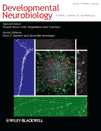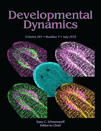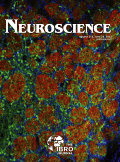
Developmental Neurobiology
Scope & Guideline
Innovating Insights into the Complexities of Development
Introduction
Aims and Scopes
- Neurodevelopmental Mechanisms:
Research examining the cellular and molecular processes that govern the development of the nervous system, including neurogenesis, synaptogenesis, and the differentiation of various neural cell types. - Environmental Influences on Neurodevelopment:
Studies exploring how external factors, such as nutrition, stress, and toxins, affect neural development and contribute to neurodevelopmental disorders. - Neuroinflammation and Neurodegeneration:
Investigations into the role of neuroinflammation in developmental processes and its implications for neurodegenerative diseases and disorders. - Model Organisms in Neurodevelopment:
Utilization of various model organisms, including zebrafish, rodents, and non-human primates, to study the genetic and environmental influences on nervous system development. - Translational Research and Therapeutics:
Research aimed at understanding the potential for therapeutic interventions in neurodevelopmental disorders, focusing on mechanisms that could lead to clinical applications.
Trending and Emerging
- Astrocyte and Microglia Functionality:
An increasing number of studies are focusing on the roles of astrocytes and microglia in neurodevelopment, highlighting their involvement in synaptic formation, neuroinflammatory responses, and neuroprotection. - Neurodevelopmental Disorders and Environmental Interactions:
Research is trending towards understanding how environmental factors, such as maternal nutrition and exposure to toxins, interact with genetic predispositions to influence neurodevelopmental disorders. - Neurotechnological Advances:
The application of advanced neurotechnologies, including optogenetics and in vivo imaging, is becoming more prevalent, allowing for deeper insights into neural circuit development and function. - Neurodevelopmental Plasticity:
There is a growing emphasis on the plasticity of the developing nervous system, with studies investigating how experiences and environmental changes can shape neural architecture and function. - Cross-Species Comparisons:
Emerging research is increasingly utilizing cross-species comparisons to understand conserved and divergent mechanisms of neurodevelopment, leveraging insights from non-traditional model organisms.
Declining or Waning
- Traditional Genetic Studies:
While genetics remains a core component of neurodevelopment research, the specific focus on classical genetic mapping and linkage studies has decreased as newer technologies, such as CRISPR and high-throughput sequencing, have emerged. - Basic Neuroanatomical Descriptions:
There has been a noticeable decline in publications that solely focus on basic descriptions of neuroanatomy without integrating functional or developmental insights, as researchers increasingly seek to connect structure with function. - Static Models of Neurodevelopment:
Research employing static models of neurodevelopment is diminishing in favor of dynamic, real-time imaging and modeling techniques that better capture the complexities of neural development.
Similar Journals

DEVELOPMENTAL DYNAMICS
Transforming Knowledge in Developmental DynamicsDEVELOPMENTAL DYNAMICS is a prominent journal in the field of Developmental Biology, published by WILEY. This esteemed journal, identifiable by its ISSN 1058-8388 and E-ISSN 1097-0177, provides a critical platform for the dissemination of innovative research covering cellular and developmental processes across diverse biological systems. With a 2023 impact factor placing it in the Q2 category of Developmental Biology and an impressive Scopus rank of #39/82, the journal plays a vital role in advancing knowledge and fostering collaboration among researchers, professionals, and students. Although it is not an open-access publication, DEVELOPMENTAL DYNAMICS remains a cornerstone in the academic community, particularly for those dedicated to understanding the complexities of biological development. The journal's convergence from 1992 to 2024 reflects its longstanding commitment to high-impact research that influences both theoretical and practical applications in the field.

Open Biology
Pioneering interdisciplinary research for a better tomorrow.Open Biology is a prestigious, interdisciplinary journal published by the Royal Society that has been paving the way in the fields of Biochemistry, Genetics and Molecular Biology, Immunology, and Neuroscience since its inception in 2011. Catering to a global audience of researchers, professionals, and students, Open Biology operates under an open access model, facilitating the unrestricted dissemination of high-quality research findings. With a current impact factor that positions its categories in the top quartile (Q1) and impressive Scopus rankings—evidencing its influence and reach—this journal serves as a vital platform for innovators and scientific inquiries aimed at advancing our understanding of life sciences. The journal's commitment to publishing cutting-edge research makes it an essential resource for those at the forefront of scientific exploration.

Russian Journal of Developmental Biology
Exploring the intricacies of life’s beginnings.The Russian Journal of Developmental Biology, published by PLEIADES PUBLISHING INC, serves as a significant platform for researchers and professionals engaged in the field of developmental biology. With the ISSN 1062-3604 and E-ISSN 1608-3326, this journal focused on intricate biological processes and dynamic developmental mechanisms from 2005 until 2017. Although its coverage is currently discontinued in Scopus, it remains notable for its contribution to understanding the pivotal roles of biochemistry and molecular genetics within the context of development. As a publication situated in the competitive quartiles of the field and boasting an influential Scopus rank of #77 out of #78, it has made a unique mark in developmental studies. Researchers and academics seeking to enhance their knowledge of historical advancements in the discipline will find the journal a valuable resource, even as it navigates the transition away from active publication.

GLIA
Innovating Insights into Neurological Functions and DisordersGLIA is a premier journal in the fields of Cellular and Molecular Neuroscience and Neurology, published by WILEY. With an impressive track record since its inception in 1988, GLIA has become an essential resource for researchers and professionals interested in the complexities of glial cells and their roles in the nervous system. Featuring articles that encompass a wide range of topics, from basic research to clinical implications, the journal is committed to advancing our understanding of neurological functions and disorders. Although not an open access publication, GLIA maintains its reputation with a significant impact factor, consistently ranking in the Q1 category as noted in 2023 Scopus rankings. With its comprehensive scope and high-quality peer-reviewed content, GLIA serves as a vital platform for disseminating groundbreaking research in the ever-evolving landscape of neuroscience.

Cells & Development
Innovating Insights into Cellular MechanismsCells & Development is a premier journal published by Elsevier, dedicated to advancing the field of Developmental Biology. With an ISSN of 2667-2901 and an impressive Q2 ranking in its category for 2023, the journal endeavors to provide a platform for high-quality research articles that explore cellular mechanisms, developmental processes, and molecular interactions that underpin growth and differentiation. Based in the Netherlands, Cells & Development not only emphasizes the importance of innovative experimental approaches but also encourages interdisciplinary contributions that bridge the gap between basic and applied science. As an Open Access publication, it ensures that research findings are readily accessible to a global audience, significantly enhancing visibility and impact. The journal's commitment to scholarly excellence makes it an essential resource for researchers, professionals, and students aiming to contribute to the dynamic field of developmental biology.

eNeuro
Innovating the future of neurobiology, one study at a time.eNeuro is a prominent open-access journal published by the Society for Neuroscience, dedicated to advancing the field of neuroscience through the dissemination of high-quality research. Launched in 2015, it reflects its commitment to accessibility by providing a platform for innovative studies and advancements in neurobiology. The journal holds a strong reputation, achieving a Q1 ranking in Medicine (miscellaneous) and a Q2 in Neuroscience (miscellaneous) as of 2023, with Scopus rankings placing it at #56 out of 113 in General Neuroscience, marking it in the 50th percentile. With its convergence to cover articles from 2014 to 2024, eNeuro continues to serve as a vital resource for researchers, professionals, and students alike, offering a comprehensive hub for the latest discoveries and theoretical developments in neuroscience. As part of its mission, eNeuro aims to foster collaboration and inspire the academic community with openly accessible content, making significant contributions to scientific discourse.

DEVELOPMENTAL CELL
Exploring the Frontiers of Cellular DiscoveryDEVELOPMENTAL CELL, published by CELL PRESS, stands as a premier journal in the fields of Biochemistry, Genetics and Molecular Biology, Cell Biology, and Developmental Biology. With a significant influence evidenced by its Q1 rankings across several categories in 2023 and a remarkable Scopus ranking placing it at the 98th percentile for Developmental Biology, this journal is pivotal for researchers and academics aiming to advance their understanding of cellular processes. Covering a broad range of topics from molecular mechanisms to cellular developmental pathways, DEVELOPMENTAL CELL publishes cutting-edge research articles that contribute to the dynamic landscape of cell biology and related disciplines. Although it does not currently offer open access, the journal is accessible through institutional subscriptions, reinforcing its commitment to disseminating high-quality scientific knowledge produced by leading experts in the field. Based in the United States, DEVELOPMENTAL CELL continues to push the boundaries of discovery and innovation in life sciences, making it an essential resource for professionals, researchers, and students alike in the quest for foundational biological insights.

DEVELOPMENT
Exploring the molecular foundations of life’s intricate designs.DEVELOPMENT is a preeminent journal published by COMPANY BIOLOGISTS LTD, headquartered in the United Kingdom. With an ISSN of 0950-1991 and an E-ISSN of 1477-9129, this esteemed journal has been at the forefront of the fields of Developmental Biology and Molecular Biology since its inception in 1987. Recognized for its rigorous peer review process and high-caliber research, DEVELOPMENT holds an impressive Q1 ranking in both disciplines as of 2023, underscoring its pivotal role in advancing scientific understanding. The journal is particularly noted for its contributions to the understanding of developmental processes, their molecular underpinnings, and their implications in health and disease. With a significant impact factor, DEVELOPMENT aims to disseminate groundbreaking research that inspires novel insights and future explorations within the biological sciences, making it an essential resource for researchers, professionals, and students alike. The journal also maintains accessibility for its readership, ensuring that significant research findings reach those who can apply and build upon them.

NEUROSCIENCE
Navigating the intricate landscape of the brain.NEUROSCIENCE, published by PERGAMON-ELSEVIER SCIENCE LTD, has established itself as a reputable journal in the field of neuroscience since its inception in 1976, continuing its contributions through 2024. With a Category Quartile ranking of Q2 in Neuroscience (miscellaneous) and a Scopus Rank of #41 out of 113, this journal represents a critical platform for the dissemination of innovative research and insights. Although it currently does not offer open access options, NEUROSCIENCE aims to advance our understanding of the nervous system by publishing high-quality original research, reviews, and methodological articles, thereby engaging a comprehensive audience of researchers, professionals, and students alike. With an impact factor that reflects its significance in the scientific community, this journal remains a go-to source for cutting-edge discoveries and scholarly discussions in the dynamic field of neuroscience.

NATURE NEUROSCIENCE
Exploring Innovative Insights in NeuroscienceNATURE NEUROSCIENCE is a premier journal published by NATURE PORTFOLIO, focusing on cutting-edge research in the field of neuroscience. With an esteemed impact factor that reflects its significance in the academic community, this journal occupies an exceptional place in the 2023 Q1 category for neuroscience (miscellaneous) and boasts a leading Scopus rank of #1 out of 113 in general neuroscience, placing it within the top 1st percentile. Since its inception in 1998, NATURE NEUROSCIENCE has consistently delivered high-quality, peer-reviewed articles that contribute to our understanding of the nervous system, driving innovation and scholarship across disciplines. Although it does not offer open access, the journal remains a vital resource for researchers, professionals, and students seeking to stay at the forefront of neuroscientific discovery and discussion. Its editorial commitment to excellence ensures that it continually shapes the trajectory of neuroscience research well into 2024 and beyond, making it an indispensable asset for anyone passionate about the brain and its complexities.